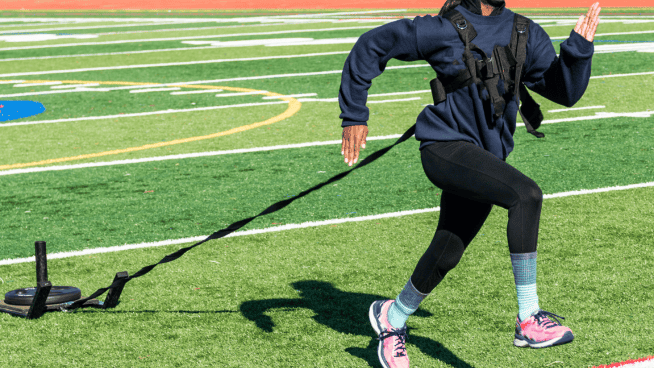Want to Improve Your Lead Leg Block? Do This in the Gym
The lead leg block is an important key to throwing velocity for baseball pitchers. As the front foot strikes the ground, the linear momentum of the lower body is stopped abruptly and transferred up the kinetic chain.

Credit: Navy Athletics
A good lead leg block; defined by high ground reaction forces (Guido and Werner, 2012) and greater knee extension at the time of maximum external rotation (van Trigt et al., 2018), is predictive of ball velocity. Ground reaction forces can reach more than double body weight in both vertical and anterior to posterior (front to back) directions (Guido et al., 2012).
With such high demands on both strength and mobility due to the amount of force that must be accepted and transferred, and the extreme position of the front leg, significant mobility and strength are prerequisites for a good lead leg block.
Many pitchers try to work on improving their lead leg mainly during throwing drills. While throwing drills are an important piece to the puzzle, without the requisite strength and mobility, an inefficient lead leg will be difficult to change.
What Makes a Good Lead Leg Block?
If we break down the lead leg block into its most basic movements, it is a combination of a hip hinge, knee extension and subsequent internal rotation around the front hip. All of these require a baseline of strength and mobility through multiple joints and muscle groups.
The hip hinge requires adequate hip flexion range of motion and hamstring length plus eccentric (muscle-lengthening) strength. Without this strength, too much knee flexion occurs, much of that energy is lost, and velocity takes a dive.
Knee extension requires adequate hamstrings length and quadriceps strength so that a powerful co-contraction of the hamstrings and quadriceps can happen when the front leg bears weight.
Lastly, internal rotation around the front hip requires, you guessed it, adequate hip internal rotation range of motion.
To make patterning changes through the use of throwing drills, you must first set yourself up with the necessary mobility and strength.
Hip Internal Rotation
Many athletes struggle with “feeling” or understanding hip internal rotation. This drill can help give them immediate feedback, while also improving their range of motion. If an athlete gets a slight cramping feeling in the outside of his hip, he is doing it correctly; if not, he is moving incorrectly or not putting maximum effort into the movement.
Hip Flexion
Sitting as low as possible during this drill can help athletes get comfortable moving in and out of more extreme hip flexion.
Hamstrings
Specificity is an important piece to getting carryover to the field. The split stance, fully extended knee, and the rotational component, can not only help improve mobility, but also help with patterning an important piece of the delivery.
Mobility is extremely important, but so is strength. They work together to help athletes move through the extreme ranges of motion necessary as part of a high-velocity delivery.
Let’s take a look at some of the strength movements.
RDLs and 1-Leg RDLs
RDLs and 1-Leg RDLs are helpful for strengthening the hip hinge pattern and developing the strength necessary to apply the anterior to posterior braking forces present in high-velocity deliveries.
Split Squat Variations
Each of the split squat variations improves unilateral strength and stability as the front leg will need to be able to handle ground reaction forces that are multiple times the body weight. The isometric split squat is the most basic variation of this movement, and can be progressed by adding a movement component and then greater range of motion via rear foot (greater hip extension demand) or front foot elevation (greater hip flexion demand).
Advanced Movements
Once an adequate foundation of strength and movement quality is built, the lead leg block can be trained more dynamically.
1-Leg Broad Jump to Jump Back
This broad jump variation is great for not only developing concentric unilateral power, but also for improving the ability to accept and redirect that power. Think about the anterior to posterior braking forces discussed earlier.
Lateral Bound to Jump Back
The lateral bound to jump back movement is similar to the broad jump above, but now we’re working on frontal plane power as well. This is a slightly more specific movement that also adds a rotational component prior to landing.
Side-Facing Split Stance Scoop Toss
This medicine ball throw variation helps to pattern upper-body rotation around a firm front leg. Notice that prior to releasing the ball my front leg stiffens up, and I finish with my upper body facing the wall due to my intent to throw the ball hard.
Give these a try and see how they help improve your on-field work.
Photo Credit: xjben/iStock
READ MORE:
RECOMMENDED FOR YOU
MOST POPULAR
Want to Improve Your Lead Leg Block? Do This in the Gym
The lead leg block is an important key to throwing velocity for baseball pitchers. As the front foot strikes the ground, the linear momentum of the lower body is stopped abruptly and transferred up the kinetic chain.

Credit: Navy Athletics
A good lead leg block; defined by high ground reaction forces (Guido and Werner, 2012) and greater knee extension at the time of maximum external rotation (van Trigt et al., 2018), is predictive of ball velocity. Ground reaction forces can reach more than double body weight in both vertical and anterior to posterior (front to back) directions (Guido et al., 2012).
With such high demands on both strength and mobility due to the amount of force that must be accepted and transferred, and the extreme position of the front leg, significant mobility and strength are prerequisites for a good lead leg block.
Many pitchers try to work on improving their lead leg mainly during throwing drills. While throwing drills are an important piece to the puzzle, without the requisite strength and mobility, an inefficient lead leg will be difficult to change.
What Makes a Good Lead Leg Block?
If we break down the lead leg block into its most basic movements, it is a combination of a hip hinge, knee extension and subsequent internal rotation around the front hip. All of these require a baseline of strength and mobility through multiple joints and muscle groups.
The hip hinge requires adequate hip flexion range of motion and hamstring length plus eccentric (muscle-lengthening) strength. Without this strength, too much knee flexion occurs, much of that energy is lost, and velocity takes a dive.
Knee extension requires adequate hamstrings length and quadriceps strength so that a powerful co-contraction of the hamstrings and quadriceps can happen when the front leg bears weight.
Lastly, internal rotation around the front hip requires, you guessed it, adequate hip internal rotation range of motion.
To make patterning changes through the use of throwing drills, you must first set yourself up with the necessary mobility and strength.
Hip Internal Rotation
Many athletes struggle with “feeling” or understanding hip internal rotation. This drill can help give them immediate feedback, while also improving their range of motion. If an athlete gets a slight cramping feeling in the outside of his hip, he is doing it correctly; if not, he is moving incorrectly or not putting maximum effort into the movement.
Hip Flexion
Sitting as low as possible during this drill can help athletes get comfortable moving in and out of more extreme hip flexion.
Hamstrings
Specificity is an important piece to getting carryover to the field. The split stance, fully extended knee, and the rotational component, can not only help improve mobility, but also help with patterning an important piece of the delivery.
Mobility is extremely important, but so is strength. They work together to help athletes move through the extreme ranges of motion necessary as part of a high-velocity delivery.
Let’s take a look at some of the strength movements.
RDLs and 1-Leg RDLs
RDLs and 1-Leg RDLs are helpful for strengthening the hip hinge pattern and developing the strength necessary to apply the anterior to posterior braking forces present in high-velocity deliveries.
Split Squat Variations
Each of the split squat variations improves unilateral strength and stability as the front leg will need to be able to handle ground reaction forces that are multiple times the body weight. The isometric split squat is the most basic variation of this movement, and can be progressed by adding a movement component and then greater range of motion via rear foot (greater hip extension demand) or front foot elevation (greater hip flexion demand).
Advanced Movements
Once an adequate foundation of strength and movement quality is built, the lead leg block can be trained more dynamically.
1-Leg Broad Jump to Jump Back
This broad jump variation is great for not only developing concentric unilateral power, but also for improving the ability to accept and redirect that power. Think about the anterior to posterior braking forces discussed earlier.
Lateral Bound to Jump Back
The lateral bound to jump back movement is similar to the broad jump above, but now we’re working on frontal plane power as well. This is a slightly more specific movement that also adds a rotational component prior to landing.
Side-Facing Split Stance Scoop Toss
This medicine ball throw variation helps to pattern upper-body rotation around a firm front leg. Notice that prior to releasing the ball my front leg stiffens up, and I finish with my upper body facing the wall due to my intent to throw the ball hard.
Give these a try and see how they help improve your on-field work.
Photo Credit: xjben/iStock
READ MORE:










